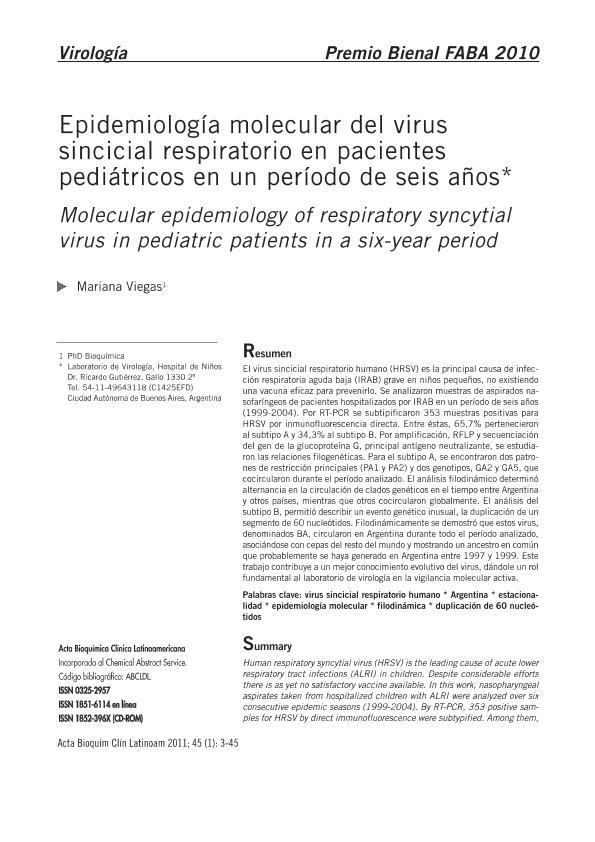Artículo
El virus sincicial respiratorio humano (HRSV) es la principal causa de infección respiratoria aguda baja (IRAB) grave en niños pequeños, no existiendo una vacuna eficaz para prevenirlo. Se analizaron muestras de aspirados nasofaríngeos de pacientes hospitalizados por IRAB en un período de seis años (1999-2004). Por RT-PCR se subtipificaron 353 muestras positivas para HRSV por inmunofluorescencia directa. Entre éstas, 65,7% pertenecieron al subtipo A y 34,3% al subtipo B. Por amplificación, RFLP y secuenciación del gen de la glucoproteína G, principal antígeno neutralizante, se estudiaron las relaciones filogenéticas. Para el subtipo A, se encontraron dos patrones de restricción principales (PA1 y PA2) y dos genotipos, GA2 y GA5, que cocircularon durante el período analizado. El análisis filodinámico determinó alternancia en la circulación de clados genéticos en el tiempo entre Argentina y otros países, mientras que otros cocircularon globalmente. El análisis del subtipo B, permitió describir un evento genético inusual, la duplicación de un segmento de 60 nucleótidos. Filodinámicamente se demostró que estos virus, denominados BA, circularon en Argentina durante todo el período analizado, asociándose con cepas del resto del mundo y mostrando un ancestro en común que probablemente se haya generado en Argentina entre 1997 y 1999. Este trabajo contribuye a un mejor conocimiento evolutivo del virus, dándole un rol fundamental al laboratorio de virología en la vigilancia molecular activa. Human respiratory syncytial virus (HRSV) is the leading cause of acute lower respiratory tract infections (ALRI) in children. Despite considerable efforts there is as yet no satisfactory vaccine available. In this work, nasopharyngeal aspirates taken from hospitalized children with ALRI were analyzed over six consecutive epidemic seasons (1999-2004). By RT-PCR, 353 positive samples for HRSV by direct immunofluorescence were subtypified. Among them, 65.7% belonged to subtype A and 34.3% to subtype B. Therefore, a phylogenetic analysis was performed using RFLP and sequence analysis of the G-glycoprotein gene, the main neutralizing antigen. The results for A subtype, showed that there were two main restriction patterns (PA1 and PA2) and two genotypes (GA2 and GA5) cocirculating during the period studied. The phylodinamic analysis showed that there were some genetic clades which along this period of time alternated their circulation between Argentina and other countries and that other clades cocirculated worldwide. The subtype B analysis enabled the description of an unusual genetic event such us a 60 nucleotide duplication. The phylodinamic analysis showed that all of these viruses, designated BA, circulated in our country during the period studied and were associated with strains reported wordlwide, showing a common ancestor which had probably been generated in a single genetic event between 1997 and 1999 in Argentina. This work contributes to a better understandig of this virus evolution, giving a fundamental role to the virology laboratory in the active molecular surveillance.
Epidemiología molecular del virus sincicial respiratorio en pacientes pediátricos en un período de seis años
Título:
Molecular epidemiology of respiratory syncytial virus in pediatric patients in a six-year period
Fecha de publicación:
02/2011
Editorial:
Federación Bioquímica de la Provincia Buenos Aires
Revista:
Acta Bioquímica Clínica Latinoamericana
ISSN:
0325-2957
e-ISSN:
1851-6114
Idioma:
Español
Tipo de recurso:
Artículo publicado
Clasificación temática:
Resumen
Palabras clave:
RSV
,
EPIDEMIOLOGÍA MOLECULAR
,
GENOTIPOS
,
FILODINÁMICA
Archivos asociados
Licencia
Identificadores
Colecciones
Articulos(SEDE CENTRAL)
Articulos de SEDE CENTRAL
Articulos de SEDE CENTRAL
Citación
Viegas, Mariana; Epidemiología molecular del virus sincicial respiratorio en pacientes pediátricos en un período de seis años; Federación Bioquímica de la Provincia Buenos Aires; Acta Bioquímica Clínica Latinoamericana; 45; 1; 2-2011; 3-45
Compartir




